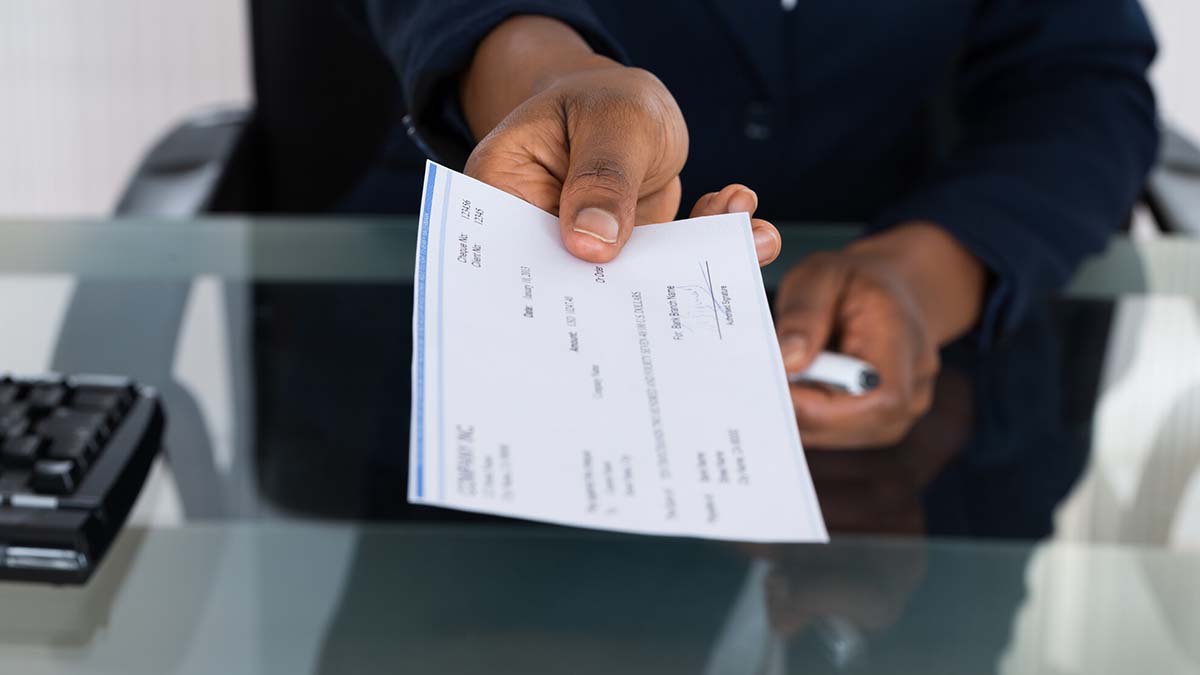Accepting check payments from customers may increase your chances of making a sale, but it comes at a price. If you receive counterfeit checks or checks from people with insufficient funds, you may have to deal with bank fees, wasted time, and lost money. To avoid these bad check nightmares, follow some standard precautions for accepting checks.
7 Precautions for accepting checks
Accepting a bad check not only means you don’t get the funds you’re owed, but your bank might also charge you a nonsufficient funds (NSF) fee. Sounds like a lot of lost money over one slip of paper, huh?
Protect your small business from the wasted time and money associated with a counterfeit or bounced check by learning how to avoid bad checks altogether.
So, what exactly are bad checks? Bad checks are checks that you can’t cash for a number of reasons, including:
- Insufficient funds in the account
- Frozen account
- Fake check
Take a look at the following seven precautions for accepting checks to get started.
1. Make sure all the parts of a check are there
Regardless of which bank issues the check to the customer, the general information comes standard. If a check doesn’t have this standard information, it might be a fake.
When a customer hands you a check, look to make sure the following information is on it:
- Payer name and address
- Payee name (i.e., you or your business)
- The amount being paid, written out
- Bank information (e.g., name, logo, website, address)
- Note about the purpose of the payment
- The bank routing number
- Check number
- Date
- The amount being paid, in numbers
- Payer’s account number
- Payer’s signature
If key parts of the check are missing (e.g., not having a signature line), don’t accept it.
2. Keep an eye out for key security features
Like cash, there are a few security features woven into checks to help recipients differentiate between a fake check vs. real check.
If you want to know how to tell if a check is real, look out for these security features on the check:
- Check stock paper (heavier than regular paper)
- Perforated edges (at least one)
- Smudge-free ink
- Watermarks
- Special fonts for the routing, account, and check numbers at the bottom
- The words “ORIGINAL DOCUMENT” on the back
You might be dealing with fraudulent checks if the above security features are absent.
3. Ask the customer for ID
To make sure a check is legitimate, ask the customer for identification. Compare the information on the customer’s ID to the check.
Pay special attention to the following information included on the customer’s ID:
- Photo
- Signature
- Name
- Address
Keep in mind that a different address on the ID vs. the check doesn’t always mean that it’s fake—it could mean that the individual just moved. However, you can refuse checks if the address differs from the one listed on the customer’s ID.
4. Get the customer’s contact information
It’s always a good idea to get a customer’s contact information, regardless of how they pay you (e.g., for future marketing efforts).
Write down their contact information so that you can get ahold of them if you’re unable to cash their check later on.
5. Be a stickler about signatures and dates
Another precaution you can take when accepting checks is to require the customer to sign it in front of you. A pre-signed check could indicate that it’s stolen or counterfeit.
You can also require customers to date the check with the current date. That way, you don’t have to worry about waiting to cash the check.
6. Try to limit checks to local banks
According to the Federal Trade Commission, another way you can limit accepting bounced or counterfeit checks is by accepting them from banks with local branches.
By only accepting checks from local banks, you can go in-person to verify the check is legitimate.
7. Use a check verification service
If you’re worried about accepting check payments, you might decide to use a check verification service. You can use a verification service to avoid accepting fake checks or checks from account holders with insufficient funds.
A check verification service can tell you if the customer has a history of bouncing checks, whether the account is legitimate and in good standing, or both.
Not all bad checks are avoidable…
If you wind up accepting a bad check, there are a few things you can do to try to secure the funds from the customer. You can:
- Ask the bank to try again or do an enforced collection
- Contact the customer and ask for payment
- Hire a collection agency
- Go to small claims court
At the end of the day, you may just have to cut your losses and move on. If you can’t get the funds from a bad check, you must:
- Write off the amount as a bad debt in your books
- Claim the bad debt on your annual business tax return
- Make a note in your system to avoid accepting checks from that customer again
- Alert authorities (if you’re dealing with a fake check)
Worried about receiving a bad check? Here are your other options
If you decide that accepting checks is just too risky for your business, take a look at the alternatives. Other payment methods include:
- Cash
- Credit cards
- Debit cards
- Mobile wallet
Keep in mind that there are risks associated with other payment methods, too. For example, you should know how to tell if money is fake to avoid accepting counterfeit bills. And, you could get hit with chargeback fraud if you accept credit card payments.
Weigh the pros and cons of accepting each payment method before coming up with your small business policy.
Regardless of what type of payment methods you accept, you need a reliable system for recording transactions. That’s where we come in. Patriot’s online accounting software makes it easy to track your small business’s incoming and outgoing money. Start your self-guided demo now!
This article is updated from its original publication date of November 19, 2019.
This is not intended as legal advice; for more information, please click here.


